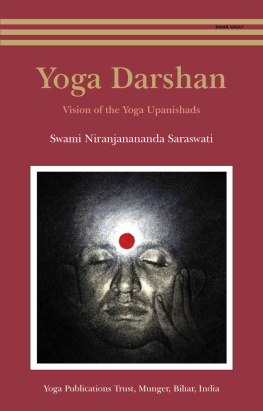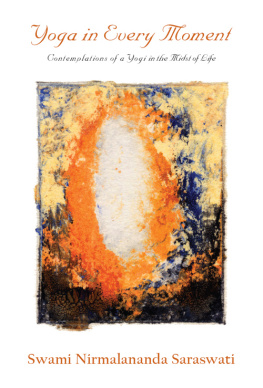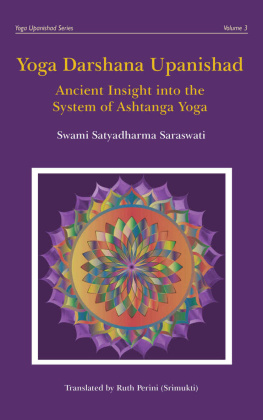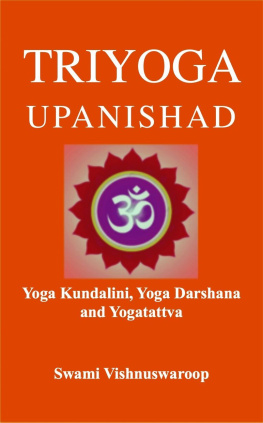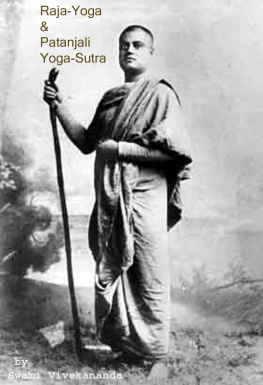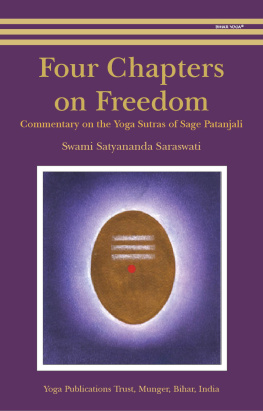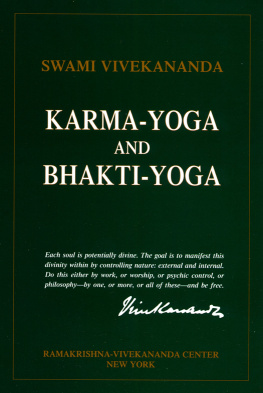Swami Niranjanananda Saraswati - Yoga Darshan: Vision of the Yoga Upanishads
Here you can read online Swami Niranjanananda Saraswati - Yoga Darshan: Vision of the Yoga Upanishads full text of the book (entire story) in english for free. Download pdf and epub, get meaning, cover and reviews about this ebook. year: 2016, publisher: Yoga Publications Trust, genre: Religion. Description of the work, (preface) as well as reviews are available. Best literature library LitArk.com created for fans of good reading and offers a wide selection of genres:
Romance novel
Science fiction
Adventure
Detective
Science
History
Home and family
Prose
Art
Politics
Computer
Non-fiction
Religion
Business
Children
Humor
Choose a favorite category and find really read worthwhile books. Enjoy immersion in the world of imagination, feel the emotions of the characters or learn something new for yourself, make an fascinating discovery.
- Book:Yoga Darshan: Vision of the Yoga Upanishads
- Author:
- Publisher:Yoga Publications Trust
- Genre:
- Year:2016
- Rating:5 / 5
- Favourites:Add to favourites
- Your mark:
- 100
- 1
- 2
- 3
- 4
- 5
Yoga Darshan: Vision of the Yoga Upanishads: summary, description and annotation
We offer to read an annotation, description, summary or preface (depends on what the author of the book "Yoga Darshan: Vision of the Yoga Upanishads" wrote himself). If you haven't found the necessary information about the book — write in the comments, we will try to find it.
Yoga Darshan: Vision of the Yoga Upanishads — read online for free the complete book (whole text) full work
Below is the text of the book, divided by pages. System saving the place of the last page read, allows you to conveniently read the book "Yoga Darshan: Vision of the Yoga Upanishads" online for free, without having to search again every time where you left off. Put a bookmark, and you can go to the page where you finished reading at any time.
Font size:
Interval:
Bookmark:
Yoga Darshan
With kind regards,  and prem
and prem

Yoga Darshan
Vision of the Yoga Upanishads
Swami Niranjanananda Saraswati
Compiled from lectures on the Yoga Upanishads
given during the Sannyasa Training Course, conducted at
Ganga Darshan from October 1992 to March 1993

Yoga Publications Trust, Munger, Bihar, India
YOGA PUBLICATIONS TRUST
Yoga Darshan
Yoga Darshan gives a contemporary yogic vision of the Upanishads as expounded by Swami Niranjanananda Saraswati. Taking a holistic and practical view of spiritual life, this text provides a picture of yoga that is both panoramic and precise.
In the theoretical section the different traditions and philosophies of yoga are clearly identified and explained along with clear expositions on hatha, raja, mantra, karma, jnana, laya and esoteric yogas. The practical section highlights classical practices from the Yoga Upanishads and the yogic perspective on physiology and health.
Yoga Darshan is a unique and improtant text authored by a modern master of the yogic sciences.
Many sannyasins have selflessly contributed to the compiling, editing and publishing of this text. To one and all, yoga aspirants extend their gratitude for bringing this information to them.
Sri Panchdashnam Paramahamsa Alakh Bara 1993
Bihar School of Yoga 2002, 2009, 2016
All rights reserved. No part of this publication may be reproduced, transmitted or stored in a retrieval system, in any form or by any means, without permission in writing from Yoga Publications Trust.
The terms Satyananda Yoga and Bihar Yoga are registered trademarks owned by International Yoga Fellowship Movement (IYFM). The use of the same in this book is with permission and should not in any way be taken as affecting the validity of the marks.
Published by Sri Panchdashnam Paramahamsa Alakh Bara
First edition 1993
Published by Yoga Publications Trust
Second edition 2002
Reprinted 2005
Third edition 2009
Reprinted 2013
First digital edition 2016
ISBN (print): 978-81-86336-26-7
ISBN eMOBI: 978-93-84753-47-4
ISBN ePUB: 978-93-84753-48-1
Publisher and distributor: Yoga Publications Trust, Ganga Darshan, Munger, Bihar, India.
Website: www.biharyoga.net

Dedication
In humility we offer this dedication to
Swami Sivananda Saraswati, who initiated
Swami Satyananda Saraswati into the secrets of yoga.
Contents
T here are two main traditions of yoga: the tantric tradition and the vedic tradition. Although the tantric tradition of yoga is more in accordance with the lifestyle we lead today, the vedic and upanishadic concept of yoga is no less relevant. The Vedas are a collection of the original, spiritual, practical, moral, social and metaphysical thoughts of seers who perceived every aspect of creation as a form or manifestation of the divine nature. They are a collection of thoughts accumulated over many generations by different saints and sages.
If these enlightened people had wanted to, they could have easily evolved their philosophy into a form of organized religion. Tantra could have become a religion, Samkhya could have become a religion, the Nyayas and Vaisheshikas could have become different religions. However, the seers said, No, we do not wish to convert our thoughts, ideas and experiences into an organized religion, because they are not the ultimate answers that we aspire for. They are an individuals understanding of reality. Therefore, let our ideas become part of a collection of ideas that deals with the same subject.
These systems of thought are known as the philosophical treatises of Sanatana culture. The collection of these ideas is called Sanatana , which means eternal. The term Sanatana encompasses these different philosophical ideas, practical instructions and guidance, the practice of yama and niyama, lifestyle and meditation, the ultimate aim being to attain the final union or merger with God.
The Vedas fall into this category. Although there have been many writers who say that the Vedas are books of Hinduism, they are under the wrong impression. This is one point that should be clarified. Indians do not have an organized structure of religion. There have been sects or traditions which evolved their own ways of worship and interpretation of the divine. These ways of worship and interpretation have become known as different isms, such as Vaishnavism, Shaktism, Shaivism and so on. They have become minor religions within the whole structure of the Sanatana culture, but the six main systems of thought which make up the Sanatana structure are not part of any religion.
Schools of thought
The six main systems of thought are: Vedanta, Samkhya, Nyaya, Vaisheshika, Uttara and Poorva Mimamsa. Then comes Tantra in all its various forms and other sub-philosophical systems. These various systems or schools of thought deal exclusively with spiritual understanding and are known as darshans, which means philosophy. At the same time, however, darshan does not just mean philosophy or school of thought, rather it means something which has been personally seen, experienced and understood. Darshan means to see, to have a vision, to have a glimpse. In the context of a school of thought, darshan means something which one has experienced. It represents an aspect of reality as perceived by oneself. Darshan is, therefore, a collection of thoughts which have actually been experienced, which are true, which are real and which are not speculation or abstract ideas. Although there are many darshans in the vedic tradition, the major ones are described here.
The first major darshan is Vedanta. Vedanta translates literally as the end of perceivable knowledge. It is comprised of the two root words, veda and anta. Veda means knowledge and anta means the end. This is the experience of the mind which is exploring its own limits and gaining a realization and an understanding of that exploration.
The second major darshan is Samkhya. Samkhya literally means numbers, but it is not a science that deals with numerology. It is a science of spirit which deals with the twenty-four attributes of our nature. These twenty-four attributes of human nature, the pure and the impure, the causal, the subtle and the gross, have been described in Samkhya.
The third major darshan is Nyaya. Nyaya literally means logic. This logic is actual recognition of spiritual experience, which is recognized by the omniscient mind, that is all encompassing and all pervading. That recognition and acceptance of an experience is taught in Nyaya. How does one understand a spiritual experience in its proper light? How does one know when an experience is just a fantasy, when it is an expression of our external nature, or when it is a real spiritual experience?
The fourth major darshan is Vaisheshika, which is a treatise on the subtle, causal and atomic principles in relation to matter and the four other elements with spirit.
The fifth and sixth darshans are Uttara and Poorva Mimamsa, which is theology divided into two parts, one in the form of questions and the other in the form of answers.
The seventh darshan is Tantra, which deals with the transcendence of human nature from the present level of evolution and understanding to transcendental knowledge, experience and awareness.
Next pageFont size:
Interval:
Bookmark:
Similar books «Yoga Darshan: Vision of the Yoga Upanishads»
Look at similar books to Yoga Darshan: Vision of the Yoga Upanishads. We have selected literature similar in name and meaning in the hope of providing readers with more options to find new, interesting, not yet read works.
Discussion, reviews of the book Yoga Darshan: Vision of the Yoga Upanishads and just readers' own opinions. Leave your comments, write what you think about the work, its meaning or the main characters. Specify what exactly you liked and what you didn't like, and why you think so.

